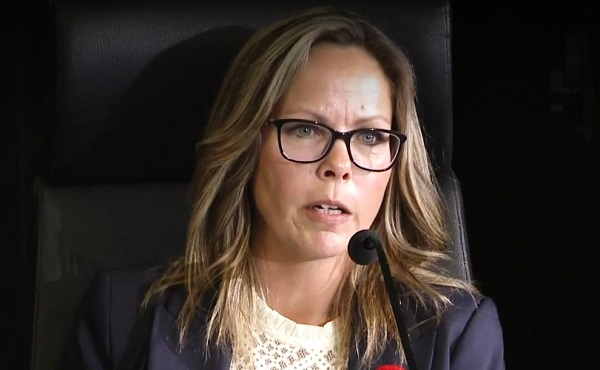Addictions
Harm reduction projects in Nelson are fraying the city’s social fabric, residents say

News release from Break The Needle
Public disorder and open drug use raise concerns in picturesque mountain-rimmed town.
“Just the other night, we had an intruder in our yard,” Kirsten Stolee recounted, her voice unsteady. Her two daughters often watch television with their windows open. “He easily could have gotten inside,” she said.
Stolee lives in Nelson, a picturesque, mountain-rimmed town in BC’s Southern Interior that is struggling with rising public disorder. Some residents, herself included, say that local harm reduction initiatives – which appear to be operating without adequate accountability and safety measures – are responsible for the decay.
Near Stolee’s house, one can find the Stepping Stones emergency shelter alongside the former Nelson Friendship Outreach Clubhouse, which used to provide support services for individuals struggling with mental health issues before being abandoned late last year.
When the clubhouse still operated, supporters claimed that it provided clients with a space to socialize and partake in “art, gardening, cooking and summer camp” – but critics countered that it was a drop-in centre for drug users. After the provincial government announced plans to open a supervised inhalation site at the clubhouse early last year, local residents protested and had the project, and eventually the clubhouse itself, shut down.
Although Stolee supports harm reduction in principle, she opposed the opening of the inhalation site on safety grounds. The incidents near her home were concerning: an assault just outside her window, a drug-addled individual stabbing a pole with scissors, people carrying weapons on the street in front of the site. When her daughter’s phone was stolen, it was eventually recovered from a man at the clubhouse.
Although the clubhouse is closed, Stepping Stones continues to operate and has been similarly chaotic. Stolee watched a suspected drug dealer attack one of the residents there, and learned that another resident had made an inappropriate comment to her daughter.
She has also observed fire hazards near local homeless encampments, including a burning electrical panel and abandoned fires, and says that local drug users “play with fires” on sidewalks and streets. She finds these incidents concerning, as BC and Alberta have recently been ravaged by large wildfires and Nelson’s downtown is filled with historic wooden architecture.
Calling the police seemed unhelpful. In one case, officers dismissed her concerns about a man who was carrying large rocks, considering him non-threatening. However, the man was later arrested for assault and for using these types of rocks to break into a gas station.
Gavin Halford, a representative of Interior Health, the provincial agency which oversees most of the region’s harm reduction programs, stated that his organization “does not tolerate or condone any form of criminal activity, including trespassing.” He claimed that Interior Health has taken “a number of steps to increase security at the Clubhouse,” including increased signage, lighting, video surveillance and on-site security services.
However, the acquisition of 24/7 security services was facilitated by Stolee’s partner, after Interior Health told him that no such options were available. The partner also alleges that he was told by local police officers that Interior Health asked them not to enforce the “No Trespassing” signs around the clubhouse.
Stolee’s family has since invested $1,000 into security upgrades such as video surveillance and fencing. “We have baseball bats and pepper spray by our front door and a bat under the bed,” she said, noting that she wrote a letter to BC Premier David Eby detailing their experiences, which received no reply.
Kari Kroker, another neighbour of Stepping Stones, said that downtown Nelson has experienced a noticeable decline as open drug use and trafficking have proliferated, including sales to youth. “The alley behind my house has become a place of screaming and chaos,” she said, expressing frustration at how some drug users have told local children that using drugs is a form of “play.”
“I’m all in favour of putting more money into this situation, but I think we’re going the cheap way,” said Kroker. “I don’t see the province doing much to solve this. I don’t see rehab and supports for people. We need rehab. Where are the facilities to support people?” She believes that the town’s social fabric is fraying and that “harmony has been completely undermined.”
Subscribe for free to get BTN’s latest news and analysis – or donate to our investigative journalism fund.
Tanya Finley, owner of Finley’s Bar and Grill and Sage Wine Bar, is an outspoken critic of provincial harm reduction policies and a leading figure in N2, the local residents’ association. She says that human feces, drug dealing, broken windows and home invasions are daily issues in her community: “Our eighty-year-old neighbour, who had just had surgery, had a brick thrown through her window.”
Finley says that her activism has had personal and professional costs and that, after she wrote a newspaper article advocating that homeless individuals be relocated to more suitable locations, a harm reduction advocate urged for a boycott of her business on social media. This led to a decline in sales and caused some of her employees to worry about their job security.
N2 was formed earlier this year after the province attempted to open the aforementioned supervised inhalation site. Local residents believed that the location of the site was unsuitably close to several youth facilities and that health authorities had, in contravention to Health Canada guidelines, failed to adequately consult the community.
“We were lied to deliberately and continuously,” said Kroker. “We found out later that this had been in the works for almost a year.”
Early efforts to address public safety concerns were undermined by accusations of NIMBYism and inadequate responses from government authorities. After N2 was formed and took collective action – such as letters to officials and media engagement – officials began to take these concerns more seriously and temporarily halted the opening of the inhalation site.
Polly Sutherland from ANKORS, a local harm reduction organization, acknowledged friction with the community but said that deteriorating public safety is largely due to limited resources. “We need more staff hours… We have the expertise and compassion for these individuals. Just give us the resources to do our jobs, and we will get it done,” she said.
She said that high rents have worsened homelessness and dereliction, and that mobile services could mitigate the concentration of public disorder in certain areas.
Nelson’s Mayor, Janice Morrison, who has had 35 years of experience working in healthcare, emphasized that municipal authority over healthcare is limited and argued for improved communication with provincial and federal agencies, which she believed needed to provide more funding.
“I think ANKORS is totally correct in that they need more staff hours and more resources,” she said, while stressing the importance of funding existing roles, such as community safety officers and outreach workers. “Drug addiction is a health issue, not a crime,” she said.
Morrison also criticized Interior Health for its inadequate community consultation regarding the placement of harm reduction sites. “They’ve had a hard go of it in their area,” the mayor said, referring to these sites’ neighbours.
Despite public safety challenges, Morrison noted that Nelson has made progress with operating several safe injection sites and would soon be adding 28 supportive housing beds. She remained committed to finding solutions despite persistent funding difficulties. “I’m ready to hear the solutions, and to support anyone with viable ideas,” she said.
Break The Needle. Our content is always free – but if you want to help us commission more high-quality journalism, consider getting a voluntary paid subscription.
Addictions
The War on Commonsense Nicotine Regulation

From the Brownstone Institute
Cigarettes kill nearly half a million Americans each year. Everyone knows it, including the Food and Drug Administration. Yet while the most lethal nicotine product remains on sale in every gas station, the FDA continues to block or delay far safer alternatives.
Nicotine pouches—small, smokeless packets tucked under the lip—deliver nicotine without burning tobacco. They eliminate the tar, carbon monoxide, and carcinogens that make cigarettes so deadly. The logic of harm reduction couldn’t be clearer: if smokers can get nicotine without smoke, millions of lives could be saved.
Sweden has already proven the point. Through widespread use of snus and nicotine pouches, the country has cut daily smoking to about 5 percent, the lowest rate in Europe. Lung-cancer deaths are less than half the continental average. This “Swedish Experience” shows that when adults are given safer options, they switch voluntarily—no prohibition required.
In the United States, however, the FDA’s tobacco division has turned this logic on its head. Since Congress gave it sweeping authority in 2009, the agency has demanded that every new product undergo a Premarket Tobacco Product Application, or PMTA, proving it is “appropriate for the protection of public health.” That sounds reasonable until you see how the process works.
Manufacturers must spend millions on speculative modeling about how their products might affect every segment of society—smokers, nonsmokers, youth, and future generations—before they can even reach the market. Unsurprisingly, almost all PMTAs have been denied or shelved. Reduced-risk products sit in limbo while Marlboros and Newports remain untouched.
Only this January did the agency relent slightly, authorizing 20 ZYN nicotine-pouch products made by Swedish Match, now owned by Philip Morris. The FDA admitted the obvious: “The data show that these specific products are appropriate for the protection of public health.” The toxic-chemical levels were far lower than in cigarettes, and adult smokers were more likely to switch than teens were to start.
The decision should have been a turning point. Instead, it exposed the double standard. Other pouch makers—especially smaller firms from Sweden and the US, such as NOAT—remain locked out of the legal market even when their products meet the same technical standards.
The FDA’s inaction has created a black market dominated by unregulated imports, many from China. According to my own research, roughly 85 percent of pouches now sold in convenience stores are technically illegal.
The agency claims that this heavy-handed approach protects kids. But youth pouch use in the US remains very low—about 1.5 percent of high-school students according to the latest National Youth Tobacco Survey—while nearly 30 million American adults still smoke. Denying safer products to millions of addicted adults because a tiny fraction of teens might experiment is the opposite of public-health logic.
There’s a better path. The FDA should base its decisions on science, not fear. If a product dramatically reduces exposure to harmful chemicals, meets strict packaging and marketing standards, and enforces Tobacco 21 age verification, it should be allowed on the market. Population-level effects can be monitored afterward through real-world data on switching and youth use. That’s how drug and vaccine regulation already works.
Sweden’s evidence shows the results of a pragmatic approach: a near-smoke-free society achieved through consumer choice, not coercion. The FDA’s own approval of ZYN proves that such products can meet its legal standard for protecting public health. The next step is consistency—apply the same rules to everyone.
Combustion, not nicotine, is the killer. Until the FDA acts on that simple truth, it will keep protecting the cigarette industry it was supposed to regulate.
Addictions
The Shaky Science Behind Harm Reduction and Pediatric Gender Medicine


By Adam Zivo
Both are shaped by radical LGBTQ activism and questionable evidence.
Over the past decade, North America embraced two disastrous public health movements: pediatric gender medicine and “harm reduction” for drug use. Though seemingly unrelated, these movements are actually ideological siblings. Both were profoundly shaped by extremist LGBTQ activism, and both have produced grievous harms by prioritizing ideology over high-quality scientific evidence.
While harm reductionists are known today for championing interventions that supposedly minimize the negative effects of drug consumption, their movement has always been connected to radical “queer” activism. This alliance began during the 1980s AIDS crisis, when some LGBTQ activists, hoping to reduce HIV infections, partnered with addicts and drug-reform advocates to run underground needle exchanges.
The Bureau is a reader-supported publication.
To receive new posts and support my work, consider becoming a free or paid subscriber.
In the early 2000s, after the North American AIDS epidemic was brought under control, many HIV organizations maintained their relevance (and funding) by pivoting to addiction issues. Despite having no background in addiction medicine, their experience with drug users in the context of infectious diseases helped them position themselves as domain experts.
These organizations tended to conceptualize addiction as an incurable infection—akin to AIDS or Hepatitis C—and as a permanent disability. They were heavily staffed by progressives who, influenced by radical theory, saw addicts as a persecuted minority group. According to them, drug use itself was not the real problem—only society’s “moralizing” norms.
These factors drove many HIV organizations to lobby aggressively for harm reduction at the expense of recovery-oriented care. Their efforts proved highly successful in Canada, where I am based, as HIV researchers were a driving force behind the implementation of supervised consumption sites and “safer supply” (free, government-supplied recreational drugs for addicts).
From the 2010s onward, the association between harm reductionism and queer radicalism only strengthened, thanks to the popularization of “intersectional” social justice activism that emphasized overlapping forms of societal oppression. Progressive advocates demanded that “marginalized” groups, including drug addicts and the LGBTQ community, show enthusiastic solidarity with one another.
These two activist camps sometimes worked on the same issues. For example, the gay community is struggling with a silent epidemic of “chemsex” (a dangerous combination of drugs and anonymous sex), which harm reductionists and queer theorists collaboratively whitewash as a “life-affirming cultural practice” that fosters “belonging.”
For the most part, though, the alliance has been characterized by shared tones and tactics—and bad epistemology. Both groups deploy politicized, low-quality research produced by ideologically driven activist-researchers. The “evidence-base” for pediatric gender medicine, for example, consists of a large number of methodologically weak studies. These often use small, non-representative samples to justify specious claims about positive outcomes. Similarly, harm reduction researchers regularly conduct semi-structured interviews with small groups of drug users. Ignoring obvious limitations, they treat this testimony as objective evidence that pro-drug policies work or are desirable.
Gender clinicians and harm reductionists are also averse to politically inconvenient data. Gender clinicians have failed to track long-term patient outcomes for medically transitioned children. In some cases, they have shunned detransitioners and excluded them from their research. Harm reductionists have conspicuously ignored the input of former addicts, who generally oppose laissez-faire drug policies, and of non-addict community members who live near harm-reduction sites.
Both fields have inflated the benefits of their interventions while concealing grievous harms. Many vulnerable children, whose gender dysphoria otherwise might have resolved naturally, were chemically castrated and given unnecessary surgeries. In parallel, supervised consumption sites and “safer supply” entrenched addiction, normalized public drug use, flooded communities with opioids, and worsened public disorder—all without saving lives.
In both domains, some experts warned about poor research practices and unmeasured harms but were silenced by activists and ideologically captured institutions. In 2015, one of Canada’s leading sexologists, Kenneth Zucker, was fired from the gender clinic he had led for decades because he opposed automatically affirming young trans-identifying patients. Analogously, dozens of Canadian health-care professionals have told me that they feared publicly criticizing aspects of the harm-reduction movement. They thought doing so could invite activist harassment while jeopardizing their jobs and grants.
By bullying critics into silence, radical activists manufactured false consensus around their projects. The harm reductionists insist, against the evidence, that safer supply saves lives. Their idea of “evidence-based policymaking” amounts to giving addicts whatever they ask for. “The science is settled!” shout the supporters of pediatric gender medicine, though several systematic reviews proved it was not.
Both movements have faced a backlash in recent years. Jurisdictions throughout the world are, thankfully, curtailing irreversible medical procedures for gender-confused youth and shifting toward a psychotherapy-based “wait and see” approach. Drug decriminalization and safer supply are mostly dead in North America and have been increasingly disavowed by once-supportive political leaders.
Harm reductionists and queer activists are trying to salvage their broken experiments, occasionally by drawing explicit parallels between their twin movements. A 2025 paper published in the International Journal of Drug Policy, for example, asserts that “efforts to control, repress, and punish drug use and queer and trans existence are rising as right-wing extremism becomes increasingly mainstream.” As such, there is an urgent need to “cultivate shared solidarity and action . . . whether by attending protests, contacting elected officials, or vocally defending these groups in hostile spaces.”
How should critics respond? They should agree with their opponents that these two radical movements are linked—and emphasize that this is, in fact, a bad thing. Large swathes of the public understand that chemically and surgically altering vulnerable children is harmful, and that addicts shouldn’t be allowed to commandeer public spaces. Helping more people grasp why these phenomena arose concurrently could help consolidate public support for reform and facilitate a return to more restrained policies.
Adam Zivo is director of the Canadian Centre for Responsible Drug Policy.
For the full experience, please upgrade your subscription and support a public interest startup.
We break international stories and this requires elite expertise, time and legal costs.
-

 Censorship Industrial Complex2 days ago
Censorship Industrial Complex2 days agoHow the UK and Canada Are Leading the West’s Descent into Digital Authoritarianism
-

 Business2 days ago
Business2 days agoCapital Flight Signals No Confidence In Carney’s Agenda
-

 International2 days ago
International2 days agoThe capital of capitalism elects a socialist mayor
-

 Daily Caller1 day ago
Daily Caller1 day agoUS Eating Canada’s Lunch While Liberals Stall – Trump Admin Announces Record-Shattering Energy Report
-

 Justice24 hours ago
Justice24 hours agoCarney government lets Supreme Court decision stand despite outrage over child porn ruling
-

 Business1 day ago
Business1 day agoThe Liberal budget is a massive FAILURE: Former Liberal Cabinet Member Dan McTeague
-

 Business1 day ago
Business1 day agoCarney’s budget spares tax status of Canadian churches, pro-life groups after backlash
-

 COVID-191 day ago
COVID-191 day agoFreedom Convoy leader Tamara Lich to appeal her recent conviction













